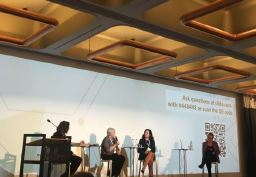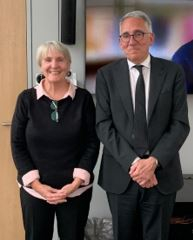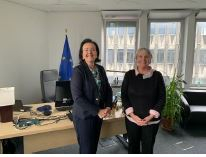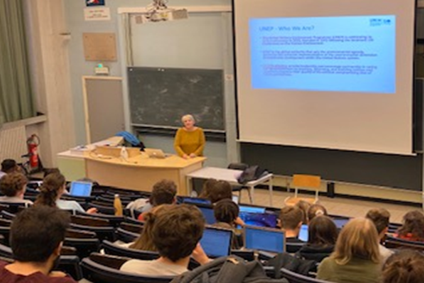UNEP Chief Scientist in Brussels to Speak of the Science-Policy Interface Addressing Environmental Crises
Discussion details
“We need scientists at the same table with decision makers to come up with the best approaches to develop and implement evidence based and effective policy to address the triple planetary crisis of climate change, biodiversity loss, pollution and waste,” said Dr Andrea Hinwood in an address to students of the Université Libre de Bruxelles (ULB) on 26 April 2022.
Five decades ago, in 1972, the Stockholm Conference created the United Nations Environment Programme (UNEP), the UN entity mandated to monitor the state of the environment, inform policymaking with science, and galvanize global action. Since then, UNEP has used its convening power and rigorous scientific research to coordinate a global effort to tackle environmental challenges. Science has unfolded the scale of the triple planetary crisis the world is facing (climate change, biodiversity loss, and pollution) and along with the environmental movement, has delivered an understanding of the solutions. The United Nations Environment Assembly (UNEA) 5.2, has called for a strengthening of the relationship or intersection between science and policy as shown by the resolution to have an open ended working group to explore the creation of a science policy panel on the sound management of chemicals and waste and pollution prevention. This global effort continues at the Stockholm+50 Conference in June 2022, where 50 years of proven environmental science and effective environmental policies will be discussed.
In the run-up to this important meeting, UNEP’s Chief Scientist, Dr Andrea Hinwood, was in Brussels at the end of April. Her mission was dedicated to discussions on the role of science in informing environmental governance in the context of upcoming global milestones, the Annex to the Memorandum of Understanding between UNEP and the European Commission for 2021-2025, UNEP’s Medium-Term Strategy, and the European Green Deal. Dr Andrea Hinwood’s programme included a guest lecture at the Université Libre de Bruxelles (ULB) on 26 April, on the topic of Science-Policy interface in support of global environmental governance.’ This article captures some of the observations she made during the lecture and the following exchange with the students.
Dr Hinwood, who is an environmental scientist with expertise in environmental exposures and impacts on human health, and a former Associate Professor at Edith Cowan University in Western Australia amongst others, spoke in the context of a course taught by Professor Wouter Achten, Programme Director of the Master in Environmental Science and Management at ULB. Over 50 students from several master programmes at the ULB, including the Master in Environmental Science and Management, the Master in Public Administration and the Master in International Relations, attended the lecture in-person. She was introduced by Professor Tom Bauler who is specialised in governance and ecological economics.
UNEP’s Chief Scientist started off by situating UNEP in the UN system and how it is placing the three environmental crises of climate change, biodiversity loss and pollution at the heart of its work. UNEP tackles these crises through transformative multi-stakeholder actions that target the root causes and drivers of the crises, she explained. This allows it to deliver a deeper and broader impact that can stimulate positive social and economic outcomes, while reducing vulnerabilities and contributing to the sustainable development agenda.
In this process, the role of science is key. Dr Hinwood explained that her role as UNEP's Chief Scientist is to ensure rigour, soundness of science, and provide strategic coordination of the science and analytics that inform the organisation’s decisions, policies, interventions, and publications.
The Science-Policy Interface has formed the backbone of UNEP’s work for the past 50 years. It has supported a multitude of mechanisms, channels, and tools in UNEP’s attempts to foster the science-to-policy link. Dr Hinwood gave examples of the science provided by UNEP and its associated centres of expertise, informing and guiding environmental governance. She highlighted for instance UNEP’s annual Emissions Gap Report in the context of global climate change negotiations, as well as its research on the methane emission reductions, on waste reduction, on the management of chemicals, and on addressing the loss of biodiversity through nature-based solutions and other emerging issues. By monitoring how countries are performing or under-performing, UNEP also plays watchdog role over internationally agreed environmental goals.

Data are essential for strengthening the science-policy interface. Providing scientific evidence can be convincing. Studies show that addressing environmental issues has positive effect in all sectors including governments and the private sector. “Half of the world’s GDP is dependent on nature, and every dollar invested in restoration creates up to 30 USD (US Dollar) in economic benefits,” Hinwood explained.
Dr Hinwood pointed out that it is key is to keep promoting science, so you become a trusted voice that can show the evidence. To do this, science must also be made available, and it must be possible for scientists to debate and discuss amongst themselves in an open way. UNEP is helping provide the safe spaces for scientists to come together to examine the evidence-based science, she told the students.
The science-policy interface should also not be only about scientists delivering wisdom to politicians, she added. It should include the diversity of voices, such as those of youth, indigenous peoples and traditional custodians of the environment, and consider gender diversity.
Asked about the role of women in science, she relayed her own experience of being a woman in the field, “I was once one of the only few women in my field, which was dominated by men at the start of my career as a young scientist in Australia. Women today are far better represented in scientific positions. The United Nations aims at recruiting more women and citizens in underrepresented countries or communities, because diversity improves overall outcomes in science and for the environment.”
Ms Hinwood ended the guest lecture session by stressing the importance of joint efforts between governments, regional environmental and monitoring networks to integrate and promote science-policy systems to support the coherence of policies such as the Green Deal and others at the global national levels.
About the mission of the Chief Scientist to Brussels: The guest lecture at the ULB took place on the second day of her mission in Brussels, Belgium from the 25th ,26th and 28th of April 2022. This mission was dedicated to a series of meetings with EU and Belgian policymakers, as well as academic networks with discussions related to global environmental governance, how science is under pressure, and how to foster the science-to-policy interface for addressing the triple planetary crisis of climate change, biodiversity loss and pollution. More precisely, she had meetings with Senior officials at the European Commission (DG Environment, DG Clima, DG Research and Innovation, DG International partnerships, DG for Civil Protection and Humanitarian Aid, the Joint Research Centre (JRC), the League of European Research Universities (LERU) and the United Nations University (UNU).

Dr Andrea Hinwood, speaking at the “Science Under Pressure Conference” on 28 April in the panel entitled “When science meets politics: the case of climate change”. watch the recording here.

Meeting with Bernard Magenhann, Deputy Director-General of the Joint Research Centre of the European Commission, on 27 April.

Dr Hinwood with Clara De La Torre, Deputy Director-General of European Commission's Directorate General for Climate Action (DG CLIMA), on 27 April.

Log in with your EU Login account to post or comment on the platform.